Winter can lead to turfgrass damage and death, causing challenges for turfgrass managers. And with a changing climate, new challenges are cropping up every year.
Eric Watkins, a professor in the Department of Horticultural Science, is seeking out answers to those challenges, most recently through an $8 million USDA Specialty Crop Research Initiative grant. His goal? To better understand the winter stresses that are placed on turfgrass and to identify solutions through plant breeding and best management practices. As Watkins explained, “This project will generate new ways of meeting winter stress challenges that will positively impact stakeholders with economic benefits such as reduced recovery costs, as well as environmental benefits such as soil stabilization and reduced runoff.”
Watkins and his collaborators have only just begun their work on this four-year project, monitoring turfgrass during the upcoming winter months to see what combinations of environmental conditions lead to winter damage. This information will help team members develop a web-based winter stress prediction application to help turfgrass managers make data-driven decisions before, during, and after winter. Results from this work will also help researchers develop new ways to select winter hardy grasses that can thrive in cold climates.
But they can’t do it alone. The team is relying on over 200 golf course superintendents from across North America and Europe to help gather data. “Our project will benefit greatly from input from these turfgrass managers,” Watkins explained. “We depend on them to provide weekly, on-the-ground data that helps us better understand winter stress damage”. At some courses, environmental sensing nodes, designed in collaboration with the GEMS Agroinformatics Initiative, will also be deployed to provide real-time data on soil and air conditions. Though they are utilizing golf courses as models for this project, the information will be used for all turfgrass management systems in cold climates.
Collaborators were quick to join this project, optimistic that winter stress damage would someday become a thing of the past. “The winter damage to golf courses not only greatly hurts the economic viability of the club, but also can ruin turf manager reputations and careers,” said Ryan Inglis, a course superintendent from Moorhead, MN. “The scope and magnitude of this research project can and will have major implications on helping turf managers all over the country and potentially the world.”
Once data is collected, the project will shift gears to study the causes of winter stress itself, from physical turfgrass injury to repetitive thawing and freezing to snow mold disease. Researchers plan to study plant physiology and freezing dynamics to better understand what happens when turfgrass freezes and thaws, something they are seeing more frequently during recent extreme winter conditions. Other researchers will study snow mold pathogens and alternative management strategies. Lastly, breeders and geneticists will identify genetic markers associated with winter stress tolerance that can be used in breeding programs to create future winter-stress-resistant cultivars.
The project’s final stage is the development of an outreach program to share resources and recommendations. “We already see a willingness to participate and a general enthusiasm for this project from our stakeholders,” Watkins said. “We plan on piloting new approaches to engage with turfgrass users of all kinds, from residential lawn owners to public agencies.”
The project team includes researchers from several departments at the University of Minnesota: Horticultural Science, Agronomy and Plant Genetics, Soil Water and Climate, Bioproducts and Biosystems Engineering, Computer Science and Engineering, USpatial, and GEMS. Collaborating institutions include the University of Wisconsin-Madison, Michigan State University, University of Massachusetts, Iowa State University, Oregon State University, Rutgers University, USDA Agricultural Research Service, and the Norwegian Institute of Bioeconomy Research.
Icon Image Photo Credit: Lily Watkins



